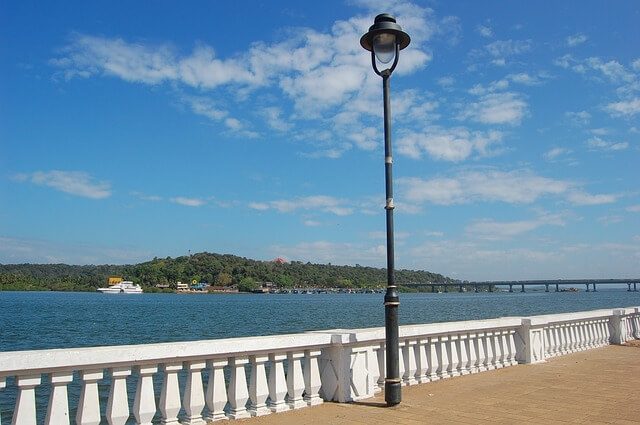‘May everyone see goodness, may none suffer any pain’
सर्वे भद्राणि पश्यन्तु मा कश्चिद् दुःखमाप्नुयात्

“The emblem of Goa State has been designed taking into consideration all the varied and rich facets of Goa’s rich cultural heritage rooted in the national ethos. It’s abundant scenic loveliness, the bounties conferred on it by nature and the significant progress achieved by its diligent and amiable people in the post-liberation era under a democratic, popularly elected regime.” states the website of the Government of Goa.
The symbol at the center of the design depicts a “Vriksha Deep”, a type of ‘divaa lamp’, the unique and world famed Goan traditional lamp which signified ‘enlightenment through knowledge’.
A circular design of coconut leaves symbolises the bountiful and beautiful Goan nature at the same time suggesting the radiation of sun rays – the source of light and energy. This surrounds the inset in a halo of suggestive glory.
The outer circle is formed partly by a Sanskrit shloka “Subhashita” (an auspicious saying) in Devanagari script above the lamp. The meaning being, “may everyone see goodness, may none suffer any pain”. (Devanagari: सर्वे भद्राणि पश्यन्तु मा कश्चिद् दुःखमाप्नुयात्; Sarve bhadrani pashyantu ma kashchid duhkhamapnuyat). The other half of the circle comprises of the wordings “Government of Goa”.
This outer circle symbolises a globe, suggesting the earth, supported by two semi-cupped hands symbolizing the sustaining constructive and protective activity of the people striving together for the progress of the state. At the top is the National Emblem of India, a lion headed crest depicting the Lions of Sarnath. Under which the Sanskrit words ‘Satyam-eva jayate’ is written in Devanagari script: सत्यमेव जयते. They literally mean ‘Truth alone triumphs’, a mantra taken from the ancient Indian scripture Mundaka Upanishad.
Information credit:http://www.hubert-herald.nl/BhaGoa.htm, Wikipedia


